Before deciding which index ETF to invest in, you can find out more on what an ETF is, or what an Index is, and why invest in ETFs here.
An Overview: CSPX vs IWDA vs VWRA
| CSPX | IWDA | VWRA | |
|---|---|---|---|
| Benchmark Index | S&P 500 | MSCI World Index | FTSE All World Index |
| Expense Ratio | 0.07% | 0.20% | 0.22% |
| Distribution Type | Accumulating | Accumulating | Accumulating |
| No. of Stocks | 505 | 1604 | 3455 |
| % of 10 largest holdings | 22.03% | 17.23% | 16.00% |
CSPX: iShares Core S&P 500 UCITS ETF USD
IWDA: iShares Core MSCI World UCITS ETF USD
VWRA: FTSE All-World UCITS ETF USD
About the Benchmark Index
S&P 500 Index: The S&P 500, or simply the S&P, is a stock market index that measures the stock performance of 500 large companies listed on stock exchanges in the United States.
From Wikipedia
MSCI World Index: The MSCI World Index is a broad global equity index that represents large and mid-cap equity performance across all 23 developed markets countries.
From www.MSCI.com
FTSE All World Index: The index measures the market performance of large- and mid-capitalisation stocks of companies located around the world.
From americas.vanguard.com
Includes approximately 3,900 holdings in nearly 50 countries, including both developed and emerging markets.
Covers more than 95% of the global investable market capitalisation.
Expense Ratio
CSPX has the lowest expense ratio at 0.07%. IWDA and VWRA are at 0.20% and 0.22% respectively.
For every $10,000 invested, you pay the following in fees:
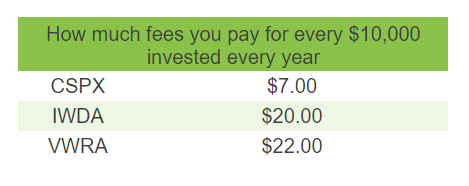
Distribution Type
As a Singaporean investor investing in these ETFs, I prefer to invest in Accumulating type ETFs. This means that all the dividend/distribution from the ETF is reinvested back into the ETF. This is more tax efficient as there is a 15% dividend tax on these Ireland Domiciled ETFs for Singaporeans. As pointed out by Oken, both Distributing and Accumulating type ETFs has tax deducted.
Differences in Composition
Region Composition
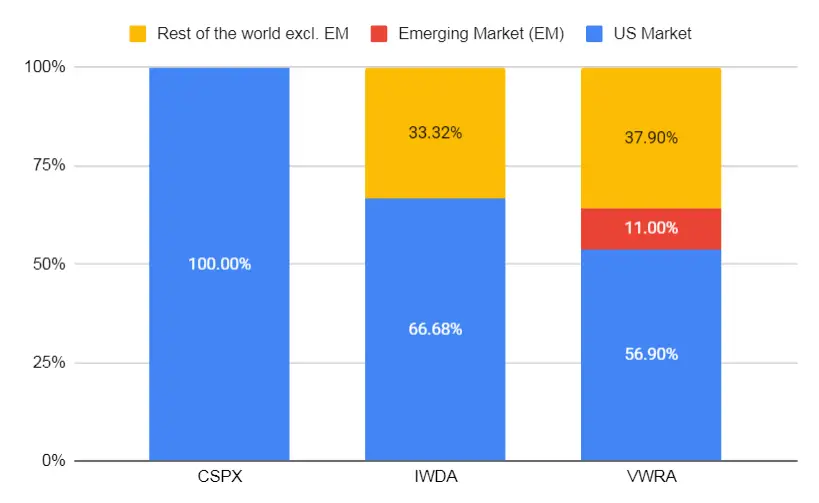
From the above chart, we can see that CSPX invests in only US Market.
IWDA invests 66.68% in US Market and 33.32% in international market excluding Emerging Market.
VWRA is the only ETF that invests in Emerging Market.
Country composition of the Emerging Market in VWRA:
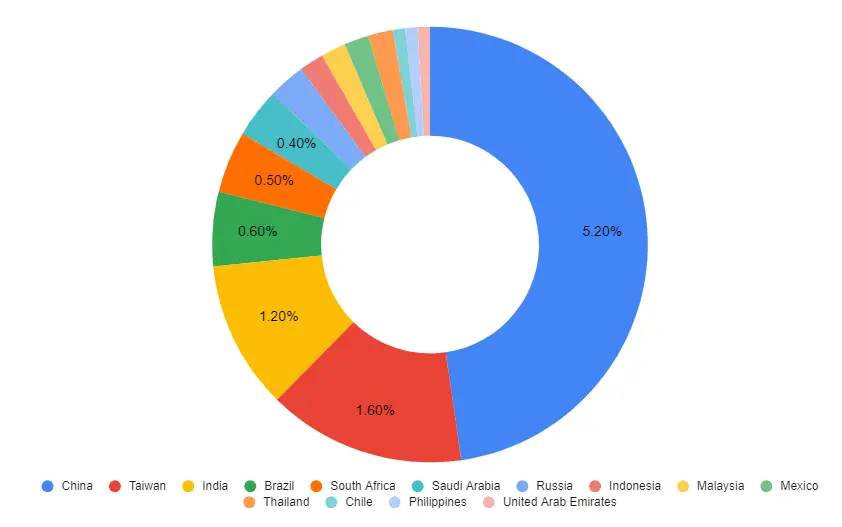
Top 10 Holdings
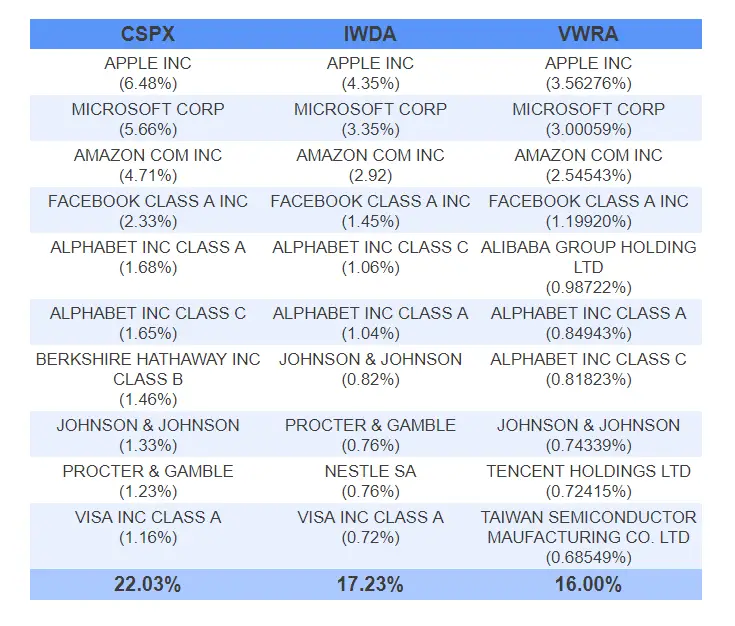
When we look at the top 10 Holdings of each of this ETF, it’s interesting to note that for CSPX and IWDA, there is only 1 company that differs. But with VWRA, we see companies from China and Taiwan in the list.
CSPX vs IWDA vs VWRA – Performance
Now that we know the main differences between these ETFs, let’s see if these leads to performance difference.
I ran a back test using BackTest on the 3 different indexes starting from 2005 with a initial investment of €10,000 (€ because it’s the only currency allowed on the site). I used the indexes because there are more historical data for indexes compared to the ETFs.
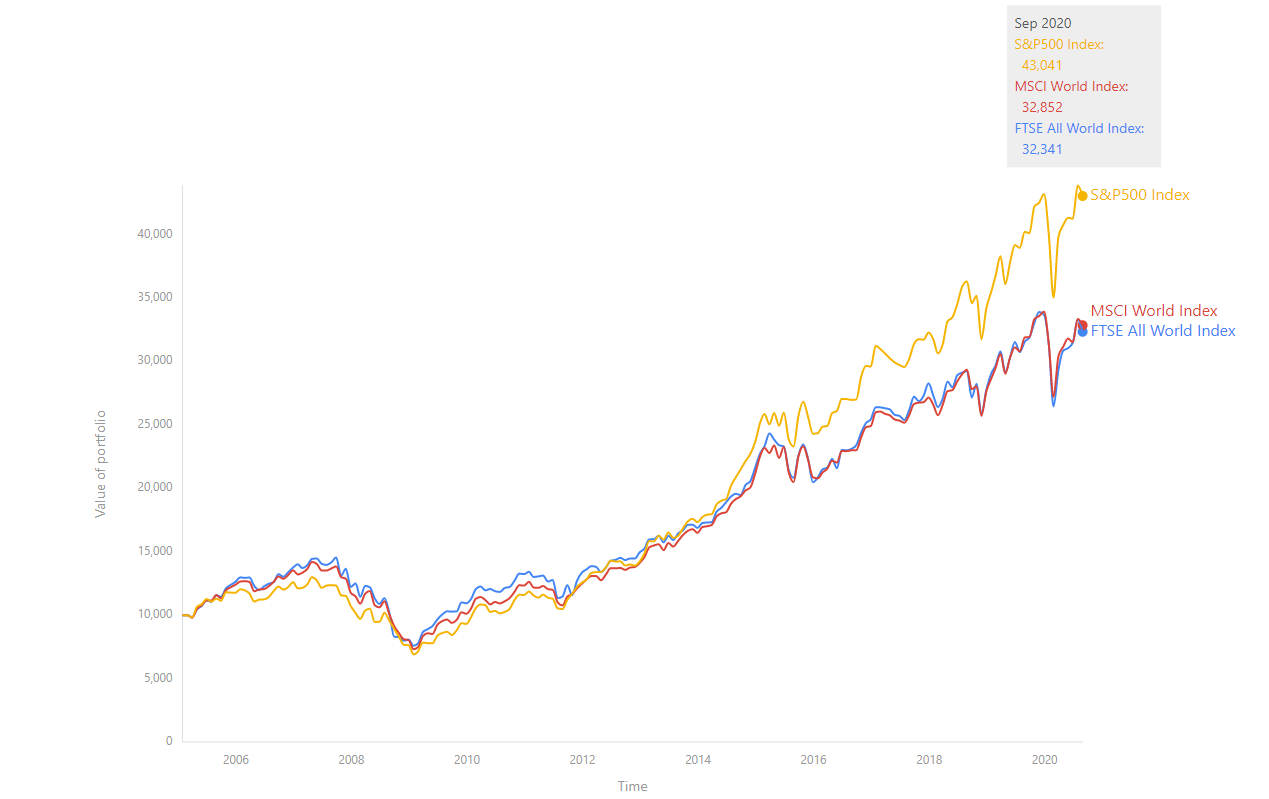
Quite interestingly, this is what you’ll end up with in Sep 2020 if you have invested €10,000 in 2005.
S&P500 (CSPX): €43,041
MSCI Word Index (IWDA): €32,852
FSTE All World Index (VWRA): €32,341
Investing in S&P500 will result in the highest growth.
Including Emerging Market doesn’t seem to make that much of a difference when you are investing in World Stocks.
Which index ETF should you invest in?
It really depends, if you are just looking for US market, then CSPX (S&P500) is the way to go.
IWDA (MSCI World Index) if you are looking at Developed Countries Market excluding Emerging Market.
VWRA (FSTE All World Index) if you are looking to include Emerging Market in your selection.
If we based on the information above, CSPX seems like a winner here with the highest growth and the lowest expense ratio.
But always remember that Past Performance is No Guarantee of Future Results.
Accumulative and Distributive ETFs have the same performance. The only difference is whether dividends are distributed or reinvested. Perhaps you could say accumulative saves on transaction fees. However, in terms of taxes, they are identical. The accumulative version would still deduct the necessary taxes before they reinvest for you.
While the past 10yrs has been dominated by the US, this has not always been the case and the rest of the world has also had long periods where it has out performed the US. The question to ask is whether you think the US will still dominate for the next ten years. Ray Dalio of Bridgewaters fame has quite a lot to say about that.
If you’d rather not bet everything you have on the US horse, then it makes sense to diversify geographically. Developed markets, as you mention, don’t differ too much from Global markets. But we need to keep in mind that China is currently classified as an emerging market. Meaning that any develop market ETF will not capture China’s stock market growth.
Hey Oken,
thanks for the note on accumulative version. I’ve update my post to reflect that.
Yea, and I totally agree with you on those global market not capturing China’s growth. Always makes me wonder why is China still considered emerging market?
And yes i do follow Ray Dalio too. and those interested can read his articles on linked-in regarding the changing world order